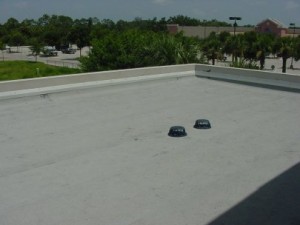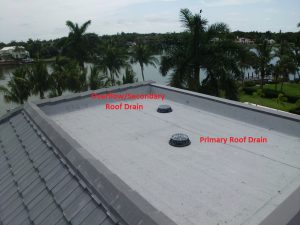Flat Roof Inspect and Maintain Roof Drains on Flat Roofs
 Roof drains can also become clogged by debris and cause major damage in a heavy rain. These need to be checked at least 4 times a year. Problem drains need to be checked once a month or once every other month. There is nowhere for the water to go, except to fill up the flat roof. Hopefully, there are overflow scuppers, which can also become clogged.
Roof drains can also become clogged by debris and cause major damage in a heavy rain. These need to be checked at least 4 times a year. Problem drains need to be checked once a month or once every other month. There is nowhere for the water to go, except to fill up the flat roof. Hopefully, there are overflow scuppers, which can also become clogged.
The roof drain inspections should be scheduled so that they coincide with the rainy season of the area. Checking them before rainy season is best, so they will perform as designed. This is important because, if they get clogged up, could cause major damage. Even with a screen or basket on the drain itself, debris can clog up the flow of drainage. Granules can get past the basket and actually clog up the pipe itself. Debris from trees can get around the basket and clog up the flow into the pipe. There are several different kinds of roof drainage that is used in different situations.
The time when the inspections will come into play is when a storm comes and dumps 8 inches of water in several hours. That is when the “performance” of your roof system and roof drainage system shows.
Just making sure there are drain baskets on them is a good idea. Many drain baskets are plastic and deteriorate over time, and just blow away. Now larger items can get down there and block it up.
Primary Roof Drain
The primary roof drain is the drain that takes all or most of the water off of the roof deck all the time. Usually the design is for this drain to be at the lowest point of the roof. As a roof and structure ages, this may not always be the case.  Also, when water penetrates the roof system, the saturated insulation can depress and make ponds around the roof drain. This is when the roof leaks start. Currently on new roofing with tapered insulation, we will design a “sump” area, which is a step down from the surrounding roof area. This way the water is channeled into the sump no matter what.
Also, when water penetrates the roof system, the saturated insulation can depress and make ponds around the roof drain. This is when the roof leaks start. Currently on new roofing with tapered insulation, we will design a “sump” area, which is a step down from the surrounding roof area. This way the water is channeled into the sump no matter what.
Secondary or Overflow Roof Drain
The secondary or overflow roof drain is a protective measure if the primary drain gets clogged. It is a good idea to check the secondary drains as well during inspection. Since they do not get flushed as much as the primary drains, they get clogged easier with small debris that gets past the drain basket.
Scuppers
A scupper is a through the wall outlet. Typically, a scupper is level with the roof surface, especially if it is the primary drainage of a flat roof. Scuppers on a flat roof can serve as primary drainage or secondary drainage. If the scupper is not level with the roof surface and is elevated several inches or a foot, it may be a secondary or overflow scupper. A scupper can be used in conjunction with a conductor head and downspout in order to further direct the water from the roof.
Downspouts
Downspouts are known for draining water out of gutters, but are also used in conjunction with scuppers to drain water. Downspouts are an important part of a drainage system as they direct where all this water is going once it hits the ground, or is directed into another drainage device. You can create a downspout to direct all the roof water to go onto the side yard or the back, instead of right beside the home.


